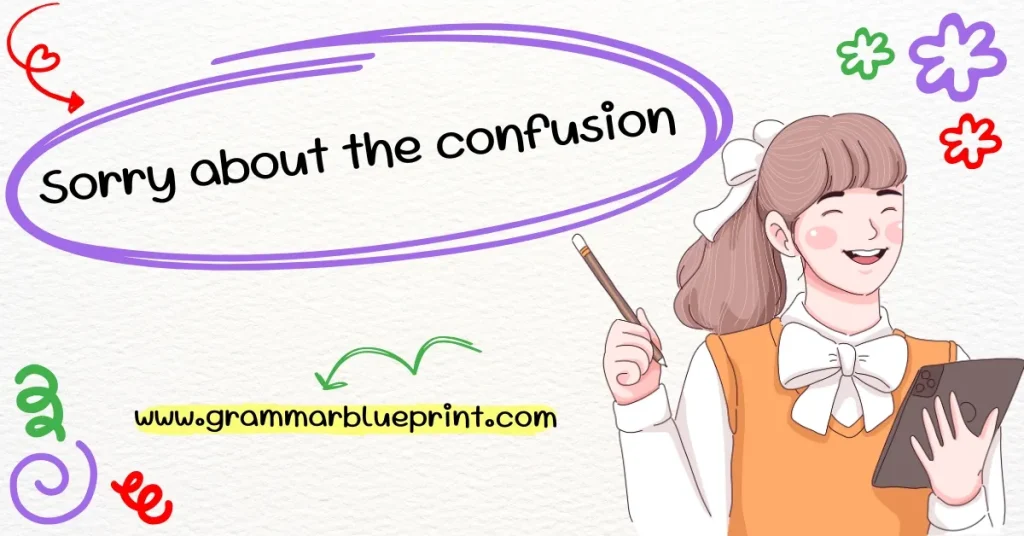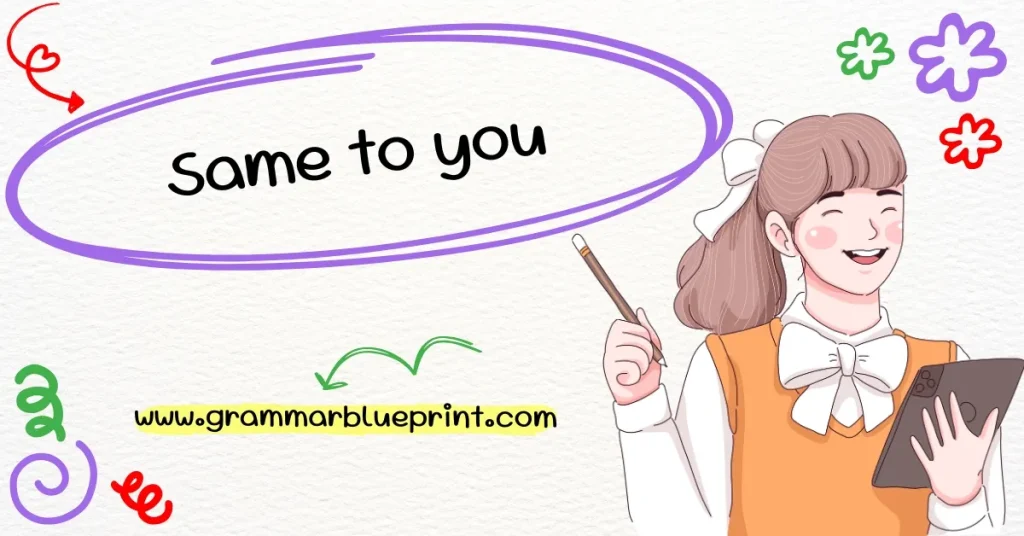In every communication, misunderstandings are inevitable. Whether in professional emails, casual conversations, or business meetings, the phrase “Sorry about the confusion” often serves as a polite way to clear things up. But what does it truly mean, and how can it be used effectively? This blog will explore its usage, alternatives, and tips for making meaningful apologies.
What Does “Sorry About the Confusion” Mean?
“Sorry about the confusion” is an expression used to apologize for causing misunderstanding or lack of clarity in a situation. It conveys regret for not being clear and acknowledges that the communication may have led to some confusion for the other person.
In daily conversations, it’s a phrase that helps smooth over any discomfort caused by miscommunication. For instance, if someone didn’t understand your instructions clearly, saying “Sorry about the confusion” signals that you recognize the issue and are trying to make things clearer.
Example:
“I just realized I sent you the wrong document. Sorry about the confusion—I’ll send the correct one right away!”
This simple phrase helps in diffusing tension and shows that you are aware of the miscommunication.
Why We Say “Sorry About the Confusion”
The phrase is commonly used to maintain good relationships and ensure that communication remains clear. When people find themselves confused due to unclear instructions or messages, a polite apology reassures them that the issue will be addressed. Saying “Sorry about the confusion” shows that you value the other person’s time and are willing to take responsibility for your part in the miscommunication.
At its core, the phrase is a tool for effective conflict resolution, signaling both empathy and accountability. By acknowledging that something went wrong, you demonstrate respect for the other person’s experience and work to clear up any misunderstanding.
How to Use “Sorry About the Confusion” in Different Situations
Formal Context
In professional settings, using “Sorry about the confusion” is a polite way to resolve misunderstandings without sounding overly casual. For instance, in an email to a colleague, you might write:
“Dear [Name],
I apologize for the confusion regarding the meeting time. Please allow me to clarify that the meeting is scheduled for 3:00 PM instead of 1:00 PM. Thank you for your understanding.”
This use is respectful and concise, perfect for business settings where clarity is key.
Informal Context
In more casual conversations, such as with friends or family, the phrase can be relaxed but still effective. For example:
“Oops, sorry about the confusion with the party details! I didn’t realize I mixed up the dates. Hope you can still make it!”
Here, the apology is informal but still acknowledges the mix-up and aims to clarify the situation.
Better Alternatives to Say “Sorry About the Confusion”
While “Sorry about the confusion” is a great starting point, there are many other ways to express apologies in English. Let’s explore some of these alternatives with their meanings, detailed explanations, and example scenarios.
Apologies for the Mix-Up
Meaning: A way of acknowledging a small mistake or mix-up.
Best Use: Ideal for both formal and informal situations when something minor has been confused.
Example: “Apologies for the mix-up with your order. Let me get the correct one for you right away.”
I Apologize for the Misunderstanding
Meaning: A more formal way to admit that something was not clearly understood.
Best Use: Use this in emails or meetings where you want to be professional.
Example: “I apologize for the misunderstanding regarding the payment terms. Let’s go over them once more to avoid any confusion.”
My Apologies for the Confusion
Meaning: A straightforward, polite apology.
Best Use: Suitable for both formal and informal contexts.
Example: “My apologies for the confusion in the schedule; I’ll send you the updated version shortly.”
Sorry for the Misunderstanding
Meaning: A commonly used phrase that implies a situation was misunderstood.
Best Use: Use this in casual conversations when clarifying a point.
Example: “Sorry for the misunderstanding, I thought you meant next Thursday instead of this one.”
I Regret the Confusion
Meaning: A formal apology that shows regret over the situation.
Best Use: Professional emails or formal written communication.
Example: “I regret the confusion surrounding the event details. I will ensure this does not happen again.”
I’m Sorry for the Inconvenience
Meaning: A polite way of apologizing for causing trouble or inconvenience.
Best Use: Useful in customer service or professional settings.
Example: “I’m sorry for the inconvenience caused by the delay. We’re working to resolve the issue as quickly as possible.”
Apologies for the Error
Meaning: A direct way to admit a mistake has occurred.
Best Use: Best used when you’ve made a clear error, whether in emails or phone calls.
Example: “Apologies for the error in the report. I’ll send over the corrected version shortly.”
I’m Sorry for the Trouble
Meaning: A way to apologize when something has caused unnecessary complications.
Best Use: For informal settings or when dealing with someone affected by the issue.
Example: “I’m sorry for the trouble with your order; let me fix it right now.”
Sorry for the Miscommunication
Meaning: Indicates that a communication failure occurred.
Best Use: In both formal and informal contexts when someone has misunderstood your message.
Example: “Sorry for the miscommunication earlier. Let me explain things clearly this time.”
I Apologize for the Mistake
Meaning: A simple way to admit a mistake and show remorse.
Best Use: Suitable in formal settings where accountability is important.
Example: “I apologize for the mistake with your invoice. We’ll correct it and send the updated version.”
Please Accept My Apologies for the Confusion
Meaning: A formal, respectful way to apologize for a misunderstanding.
Best Use: Appropriate in formal emails or official communications where a more polished tone is needed.
Example: “Please accept my apologies for the confusion regarding the project timeline. We will clarify everything in the upcoming meeting.”
I Regret the Misunderstanding
Meaning: A way to express regret for something that was misunderstood.
Best Use: Used in both formal and informal contexts, particularly when you want to express a deep sense of regret.
Example: “I regret the misunderstanding about the payment schedule. Let’s ensure we’re on the same page moving forward.”
Sorry for the Confusion Caused
Meaning: A direct acknowledgment that confusion has occurred due to your actions.
Best Use: Often used in informal or semi-formal settings where you want to directly address the impact of your actions.
Example: “Sorry for the confusion caused by the email. I will resend the correct details.”
I’m Sorry if I Caused Any Confusion
Meaning: A softer, less direct apology that shows empathy for any confusion.
Best Use: Great for casual conversations or situations where you want to sound considerate without assuming full responsibility.
Example: “I’m sorry if I caused any confusion with the details in my last message. I’ll clarify things now.”
I Apologize for Any Misunderstanding
Meaning: A polite apology acknowledging that a misunderstanding has occurred.
Best Use: Useful in both formal and informal contexts when acknowledging a minor issue.
Example: “I apologize for any misunderstanding that might have occurred regarding the meeting schedule.”
I’m Sorry for the Disruption
Meaning: A way to apologize for causing an interruption or disturbance in a situation.
Best Use: More suited for situations where your actions have disrupted something, such as a meeting or an event.
Example: “I’m sorry for the disruption earlier. Let’s get back to work and finish up the project.”
Apologies for the Lack of Clarity
Meaning: An acknowledgment that the communication was unclear or vague.
Best Use: Suitable when explaining an unclear message, often used in emails or presentations.
Example: “Apologies for the lack of clarity in my instructions. I’ll send more detailed information shortly.”
I Regret Any Confusion This May Have Caused
Meaning: A formal apology expressing regret for any confusion your actions may have created.
Best Use: Ideal for professional or customer service situations where you want to acknowledge the impact of confusion.
Example: “I regret any confusion this may have caused regarding the schedule. Let’s work together to resolve it.”
Sorry for the Unclear Communication
Meaning: A direct apology for not communicating clearly.
Best Use: Useful in situations where your message was vague, unclear, or misunderstood.
Example: “Sorry for the unclear communication in my last email. I’ll explain the details more clearly now.”
I Apologize for Any Confusion
Meaning: A simple, straightforward apology acknowledging confusion.
Best Use: Works well in any setting where you need to apologize for causing confusion, whether formal or informal.
Example: “I apologize for any confusion caused by my previous email. Let me clarify things for you.”
I’m Sorry if Things Weren’t Clear
Meaning: A less formal apology for situations where clarity was lacking.
Best Use: Suitable for informal settings, especially when you want to keep the tone light while still addressing the confusion.
Example: “I’m sorry if things weren’t clear in my last message. Let me try to explain it better.”
Apologies for the Ambiguity
Meaning: A formal apology acknowledging that your message was ambiguous.
Best Use: Perfect in professional contexts where you want to address a situation that could have been interpreted in multiple ways.
Example: “Apologies for the ambiguity in my earlier communication. Let me provide a clearer explanation.”
I’m Sorry for Any Mix-Up
Meaning: A casual apology for a minor mistake or confusion.
Best Use: Informal settings, especially when the mix-up was not a major issue but still needs addressing.
Example: “I’m sorry for any mix-up with the schedules. I’ll make sure everything is set for tomorrow.”
I’m Sorry for the Lack of Understanding
Meaning: An apology recognizing that the situation may not have been fully understood.
Best Use: Ideal for situations where communication failed, and the listener didn’t fully grasp the point you were making.
Example: “I’m sorry for the lack of understanding on my part. Let’s go over the details again.”
Apologies for Any Confusion That Arose
Meaning: A formal apology that addresses confusion that has emerged.
Best Use: Suitable in customer service or professional settings where confusion needs to be addressed and resolved.
Example: “Apologies for any confusion that arose during our conversation. Let’s clarify the points you mentioned.”
Sorry for Any Confusion on My Part
Meaning: A way to acknowledge that the confusion was caused by something you did.
Best Use: Best in situations where you realize your actions or communication contributed to the confusion.
Example: “Sorry for any confusion on my part. I’ll make sure I explain things better this time.”
I Apologize for Any Unclear Explanations
Meaning: A specific apology for not explaining something clearly enough.
Best Use: Works well in both formal and informal settings, especially when you realize that your explanations were insufficient.
Example: “I apologize for any unclear explanations in my last message. Let me provide further details.”
I’m Sorry if There Was Any Miscommunication
Meaning: A polite acknowledgment of miscommunication, with a softer approach.
Best Use: Effective in casual settings where you want to gently address confusion without assigning blame.
Example: “I’m sorry if there was any miscommunication about the meeting time. Let’s confirm the details.”
I Regret the Mi3x-Up
Meaning: A formal way to express regret for a confusion or error.
Best Use: Ideal for professional settings or situations where you want to express deeper regret.
Example: “I regret the mix-up with your schedule. Let’s work together to resolve this issue.”
My Apologies for the Misunderstanding Earlier
Meaning: A direct apology for a misunderstanding that happened in the past.
Best Use: Suitable for follow-up situations where a previous conversation or interaction caused confusion.
Example: “My apologies for the misunderstanding earlier. Let me provide further clarification to avoid any further issues.”
Benefits of Saying “Sorry About the Confusion”
- Maintaining Relationships and Communication
Saying “Sorry about the confusion” can strengthen relationships. It shows that you care about the other person’s experience and are willing to correct any misunderstandings. - Showing Respect and Responsibility
Apologizing acknowledges that you recognize your part in the confusion and take responsibility for it. This shows respect for the other person’s time and clarity. - Building Trust
Offering an apology when things go wrong fosters trust. It signals that you are reliable and accountable for your actions, which is essential in both personal and professional relationships.
How to Apologize Effectively Beyond “Sorry About the Confusion”
When it comes to giving a sincere apology, there’s more to it than just saying “sorry.” Here are the key components of an effective apology:
- Acknowledge the Mistake: Clearly state what went wrong.
- Take Responsibility: Own up to your actions and avoid shifting blame.
- Express Regret: Show that you genuinely care about the impact your actions had on others.
- Offer a Solution: Whenever possible, explain how you plan to rectify the situation.
- Ensure It Won’t Happen Again: Reassure the other person that you will take steps to prevent a repeat of the mistake.
Common Mistakes in Using “Sorry About the Confusion”
- Over-Apologizing
Constantly saying sorry can weaken the impact of your apology. It may come across as insincere or unconvincing. - Using the Phrase Too Casually
While “Sorry about the confusion” is a polite phrase, using it too casually in serious situations may diminish its sincerity.
Cultural Considerations When Using Apologies
Different cultures view apologies differently, and being culturally sensitive is key. In some cultures, offering an apology is an essential part of maintaining harmony, while in others, it might be seen as a sign of weakness. Therefore, understanding the cultural context is important when using phrases like “Sorry about the confusion.”



